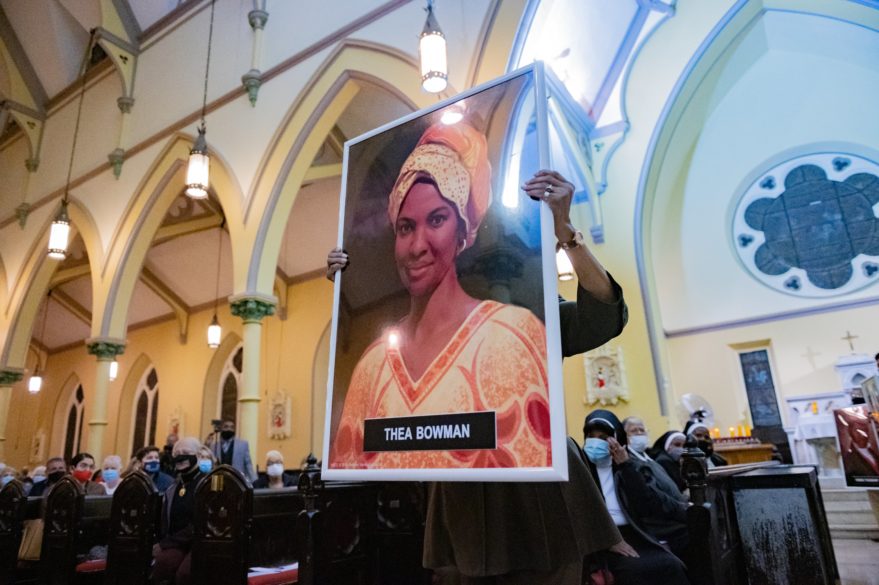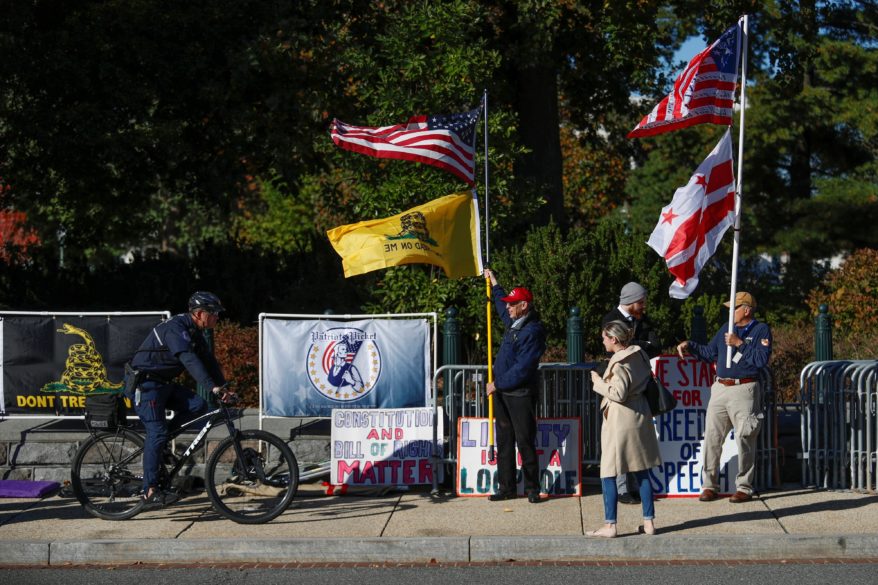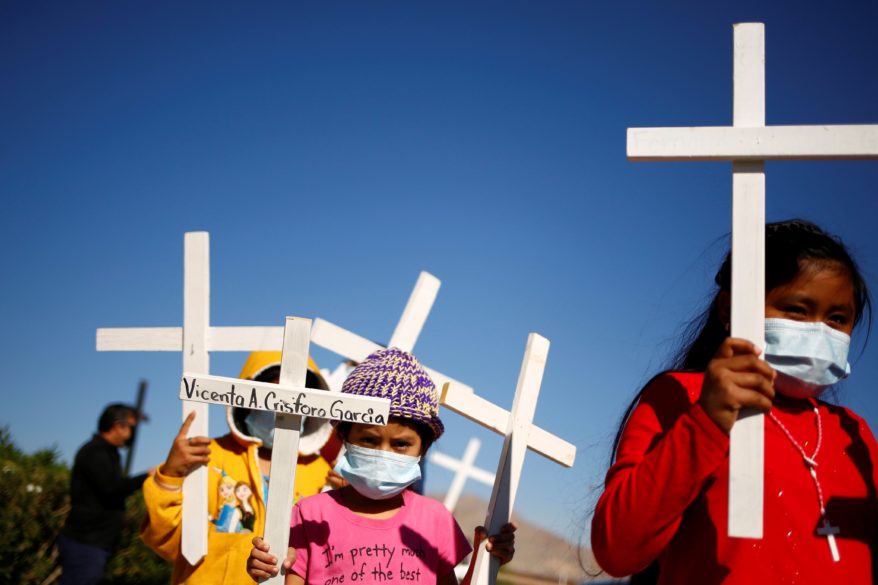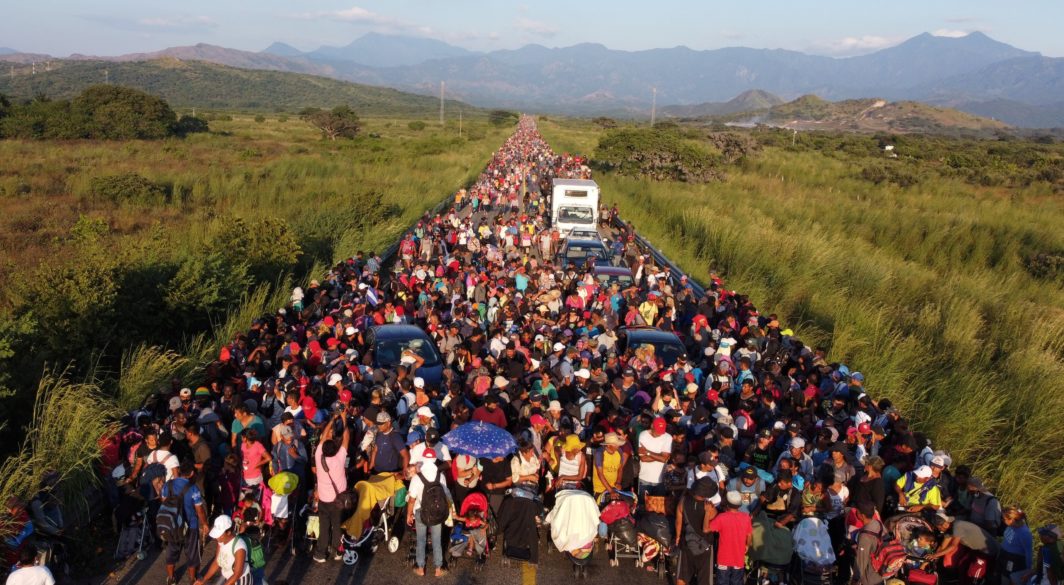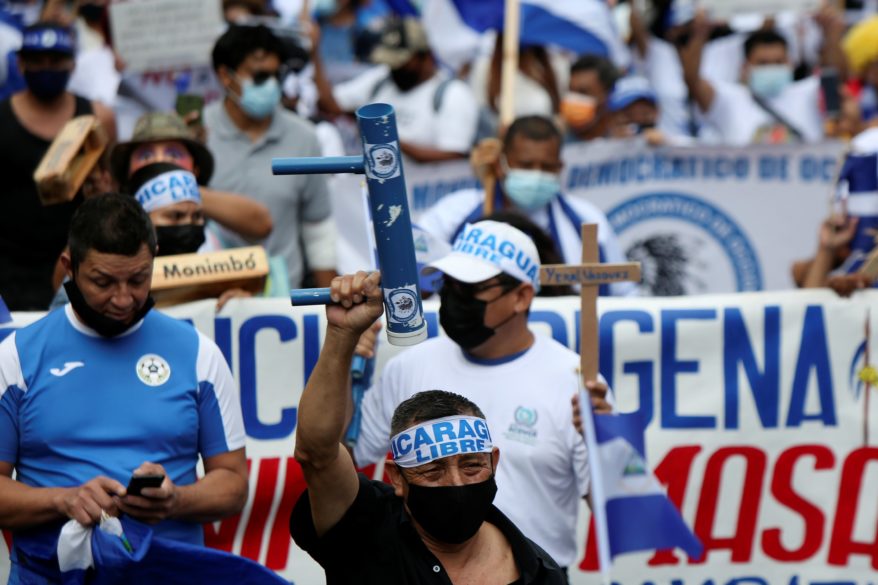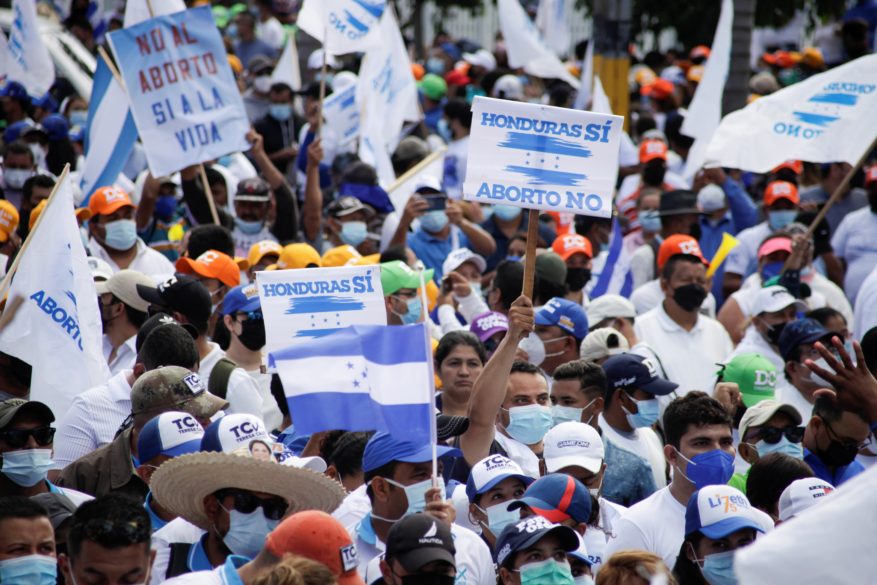By Carol Zimmermann
BALTIMORE (CNS) – The U.S. bishops’ focus on the significance of the Eucharist in the life of the church isn’t just about on the statement they approved at their fall meeting.
It also is about something bigger: a three-year eucharistic revival that will culminate with the National Eucharistic Congress 2024 in Indianapolis.
The bishops approved a motion Nov. 17 during their general assembly in Baltimore to host this congress with 201 votes in favor, 17 against and five abstentions.
Auxiliary Bishop Andrew H. Cozzens of St. Paul and Minneapolis, who was recently named bishop of Crookston, Minnesota, gave the bishops details about this planned revival just before they voted on it.
The bishop, who is chairman of the U.S. Conference of Catholic Bishops’ Committee on Evangelization and Catechesis, said the revival could be a time of healing for the entire church as well as a movement of evangelization and a reawakening of understanding of the sacrament of the Eucharist for Catholics across the country.
The revival will officially start on the feast of Corpus Christi June 16, 2022, with a diocesan focus that will include eucharistic processions and other events of adoration and prayer around the country.
In 2023, the emphasis will be on parishes and resources aimed at increasing Catholics’ understanding of what the Eucharist really means.
Part of the impetus prompting this effort was a Pew study in the fall of 2019 that showed just 30% of Catholics understand the real presence of Christ in the Eucharist.
Bishop Cozzens noted the price tag for the National Eucharistic Congress – $28 million – is expensive, but said it is worth it and can be doable with fundraising.
He said many apostolates and ministries are donating time and resources to help make the eucharistic revival a reality.
Some bishops questioned the cost of the congress that wraps up this venture, but others spoke about the potential this will have to bring Catholics back to the church and bring those in the church to a deeper sense of devotion and a stronger faith.
Bishop Cozzens pointed out that such large-scale church events can be transformative and said the National Eucharistic Congress may end up being something the Catholic Church revisits 10 years from now.
Blessed Carlo Acutis will be the patron for the first year of the revival. The Italian teen, who was beatified in October 2020, died of leukemia in 2006 at age 15. He was a programmer who used social media to unite many people and spread Christian values.
In his apostolic letter proclaiming the youth “blessed,” Pope Francis said he “cultivated a friendship with our Lord Jesus, placing the Eucharist and the witness of charity at the center of his life.”
Category Archives: U.S. News
Papal nuncio urges U.S. bishops to closely listen to the church
By Carol Zimmermann
BALTIMORE (CNS) – Archbishop Christophe Pierre, the apostolic nuncio to the United States, spoke to the U.S. bishops Nov. 16 about the importance of listening to people in the church and being open to the work of the Holy Spirit.
He addressed the bishops on the first day of two days of public sessions at their fall general assembly Nov. 15-18 in Baltimore.
The archbishop noted that he has been in the role of apostolic nuncio for five years and has been on a journey with the U.S. bishops through challenges of religious disaffiliation, the sexual abuse crisis, increasing secularization, polarization within the nation and the church, and most recently the global pandemic.
He quickly jumped into discussing a topic fresh on the bishops’ minds from hearing about it the previous night at their opening Mass and one they will continue discussing in preparation for an upcoming world Synod of Bishops: synodality.
“I believe that synodality is an answer to the challenges of our time and to the confrontation, which is threatening to divide this country, and which also has its echoes in the church,” Archbishop Pierre said.
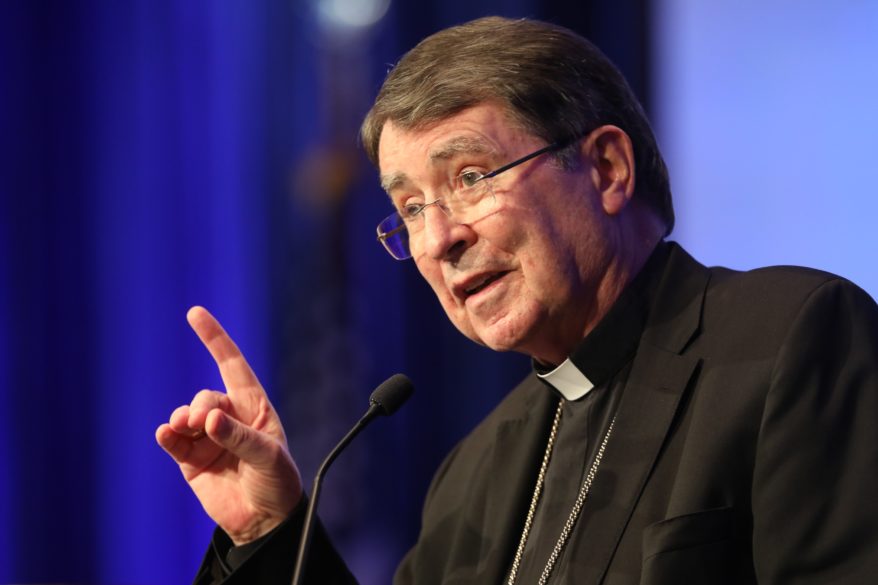
“It seems that many are unaware they are engaged in this confrontation, staking out positions, rooted in certain truths but which are isolated in the world of ideas and not applied to the reality of the lived faith experience of the people of God in their concrete situations,” he said.
To define this often-repeated word in church circles today, the nuncio explained what it is not. He said synodality is not “a meeting about meetings” and went a step further to jokingly say: “If that were the case, we would certainly be in one of the lower rings of hell in Dante’s ‘Inferno.’”
He stressed that the term – and what the church is engaged in right now in the listening phase in preparation for the 2023 synod – goes beyond the physical act of hearing people to actually being close to them.
For the bishops, he said, this process should start at home by listening to each other. “The church needs this attentive listening now more than ever if she is to overcome the polarization facing this country,” he said.
The bishops’ act of listening also is a means of leading by example to help U.S. Catholics be missionary disciples engaged in their own listening and discernment that he said should be a “way of life” in families, parishes, dioceses and on the periphery.
But for all this to happen, there also has to be overall unity because, he said, “a divided church will never lead people to where it should be.”
Throughout his half-hour address to the bishops, the nuncio continued to drive home the message that more needs to be done to bring the church to where it should be.
For example, when he mentioned that the church “should be unapologetically pro-life,” he stressed the need to look at causes and factors that lead women to seek abortions and then to reach out in practical ways to mothers in need.
Along that same line, he said the church needs to address racism and should go further with that by acknowledging “the lived reality” many in the church experience each day.
Also, regarding the Eucharist, he said people can have theological ideas about the Eucharist, which are important, but “none of these ideas compare with the reality of the eucharistic mystery, which needs to be discovered and rediscovered through the practical experience of the church, living in communion, particularly in this time of pandemic.”
The nuncio, hinting at a topic the bishops planned to address in their discussion of their proposed statement on the Eucharist, said many can “miss the true encounter” of the real presence of Christ in the Eucharist.
He also noted that there is “the temptation to treat the Eucharist as something to be offered to the privileged few rather than to seek to walk with those whose theology or discipleship is falling short, assisting them to understand and appreciate the gift of the Eucharist, and helping them to overcome their difficulties.”
Looking back and ahead, the archbishop, who was appointed U.S. nuncio in April 2016, reiterated that he and the bishops had “been on the road together for more than five years” and that they would journey forward, in unity, by “listening to one another and to the Spirit and walking with our brothers and sisters.”
“We will emerge from the present crises together,” he said, “as the church Christ has called us to be.”
Briefs
NATION
BALTIMORE (CNS) – A funeral Mass was offered Nov. 23 at St. Peter Claver Church in West Baltimore for Beverly A. Carroll, a social justice advocate who spent her life raising her voice for African American Catholics in the Archdiocese of Baltimore, the United States and the world. Carroll, the founding director of the U.S. Conference of Catholic Bishops’ Secretariat for Black Catholics, died Nov. 13. She was 75. Bishop John H. Ricard, a former auxiliary bishop of Baltimore and current superior general of the Baltimore-based Josephites, celebrated the Mass for his friend. Carroll worked for many years with Bishop Ricard, who also is the retired bishop of Pensacola-Tallahassee. “She was a great advocate for the community, for the church, for African Americans in the church,” said Josephite Father Ray P. Bomberger, pastor of St. Peter Claver Parish, to which Carroll belonged her whole life. “She was interested in the church, the people of the church, what was going on, (and) how we could do it better,” he said. Father Bomberger praised Carroll’s devotion to her church, both in her home community and around the country, as well as her interest in education and social justice. Carroll was a lifelong parishioner of St. Peter Claver, where she served as a corporator and parish council member.
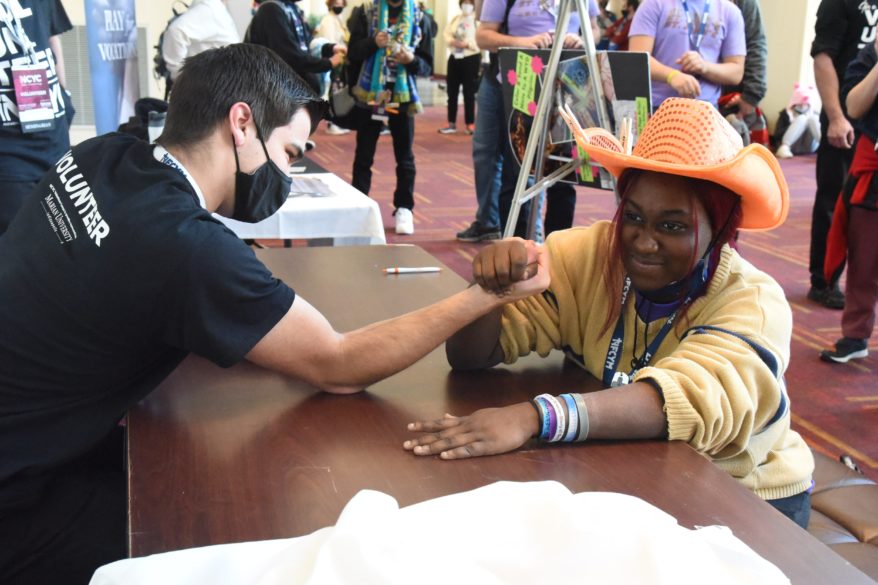
INDIANAPOLIS (CNS) – “Follow me to arm-wrestle a seminarian! See if you can beat a man who receives Communion every day!” Holding a chalk board with “Arm Wrestle a Seminarian” written on it, seminarian Samuel Hansen barked his invitation while walking through the halls of the Indiana Convention Center Nov. 20, the final day of the National Catholic Youth Conference. “It was incredibly fun,” said Hansen, a senior at Bishop Simon Bruté College Seminary and a member of St. Roch Parish, both in Indianapolis. “Just walking with the sign made a lot of people laugh. I felt like a ballpark food salesman. But it energized the convention center quite a bit.” In response to Hansen’s hawking, a steady group of challengers gathered around a table promoting vocations to the diocesan priesthood that had earlier attracted fewer visitors when the seminarians manning it waited for NCYC participants to come to them on their own. As lighthearted and winsome as his strategy to attract attention was, Hansen saw it as following in the tradition of the saints. St. John Bosco, for example, did sleight-of-hand tricks and juggling acts for kids in his village to get them to listen to his catechesis lesson. The NCYC always includes a thematic area made up of villages, or venues, in the convention hall that have traditional exhibits as well as interactive educational and recreational activities for attendees. “The saints stepped out of line and took extraordinary actions to inspire others,” Hansen told The Criterion, newspaper of the Archdiocese of Indianapolis.
VATICAN
VATICAN CITY (CNS) – Pope Francis signed a decree recognizing a miracle attributed to the intercession of Blessed Titus Brandsma, clearing the way for the canonization of the 20th-century martyr murdered at the Dachau concentration camp. The Dutch Carmelite friar was sent to Dachau for treason – after defending Jews and press freedom – and was killed with a lethal injection. The Vatican announced Pope Francis’ decision in his case and a number of other sainthood causes Nov. 25. Dachau, the notorious Nazi concentration camp in Germany most associated with the genocide of thousands of Jews during World War II, also held more than 2,700 clergy – 2,400 of them Catholic priests. Blessed Brandsma was sent there after urging editors of the Dutch Catholic press to violate a new law of the Third Reich and not print any Nazi propaganda. He also denounced Nazism as “a sewer of falsehood that must not be tolerated,” said Dianne Traflet, an assistant professor of pastoral theology and the associate dean of graduate studies at Seton Hall University in South Orange, New Jersey, during a talk at the national World War II Museum in 2018. Pope Francis also recognized a miracle attributed to the intercession of Blessed Carolina Santocanale, also known as Blessed Mary of Jesus, an Italian nun born in 1852, who founded the Congregation of the Capuchin Sisters of the Immaculate of Lourdes. The Vatican did not immediately announce dates for the canonization ceremonies.
WORLD
ANKAWA, Iraq (CNS) – Walking through this mainly Christian town outside of Irbil, the capital of Iraqi Kurdistan, it’s easy to see many changes since the victims of Islamic State militants fled here for safety seven years ago. Gone are the tents and caravans that dotted church yards and open fields to house those escaping forced conversion to Islam or death at the hands of the Islamic State militants in 2014. Colorful laundry once hung from balconies, while some people slept on church pews. The cavernous concrete skeleton of a shopping mall then sheltered 2,500 displaced people. Support from Catholic and other churches built and cordoned off rooms on three-stories; each room housed a single family, and all shared basic cooking and bathroom facilities. The unfinished structure has given way to the Ankawa Mall, where people can food shop at the French Carrefour supermarket, eat in a Turkish restaurant or buy Hello Kitty accessories at a Japanese import shop. In 2017, the Iraqi military and U.S.-led coalition troops forced out Islamic State fighters. Since then, Catholic churches and organizations have been working hard to address challenges faced by Iraq’s historic Christian community and other religious minorities. “People have faced tremendous difficulties and wounding by the Islamic State. We are still experiencing the practical effects of loss and trauma,” said Fadi, an Armenian Christian worshipping at a local church. Chaldean Catholic Archbishop Bashar Warda of Irbil stewarded the building of four schools, a university and a hospital, providing local people with badly needed employment, with assistance from Stephen Rasche, who is counsel to the Chaldean Archdiocese of Irbil.
VANCOUVER, British Columbia (CNS) – When Father Francis Galvan left Sacred Heart Church in Delta Nov. 15, he did not expect to find himself at the center of a catastrophic flood and what is being called the storm of the century. But within hours, the Augustinian priest was at ground zero of rescue efforts and witnessing humanity at its best, joining with Agassiz residents in responding to the needs of stranded travelers. “There I saw and realized how the human heart in the worst situations comes out its best – eyes looking only at those in need of help,” he told The B.C. Catholic, newspaper of the Vancouver Archdiocese, by email. Father Galvan arrived in Harrison Hot Springs only to find the study week canceled due to torrential rains, so he headed over to St. Anthony of Padua Church in Agassiz to check in with pastor Father Dennis Flores. There, the two priests saw rescue helicopters flying overhead and decided to head to the town’s community center. They found themselves in the middle of a massive rescue and relief effort. “Strong winds were blowing along with heavy rains, and I watched rescue helicopters landing, one after another,” Father Galvan said. Evacuees who had been stranded by highway mudslides emerged from the helicopters.
More than 4,200 allegations of clergy abuse reported, annual audit shows
Anyone who has been a victim of abuse or exploitation by clergy, religious or lay church personnel and has not yet reported it is encouraged to do so.
Our victim assistance coordinator, Erika Rojas, a licensed social worker, is available to assist in making a report. Please contact her at (601) 326-3760.
To report an allegation of abuse or mishandling of allegations of sexual abuse by a bishop, please visit https://reportbishopabuse.org.
By Catholic News Service
WASHINGTON – More than 4,200 allegations of sexual abuse of minors by Catholic clergy and others were reported during the year ending June 30, 2020, a slight decline from the previous auditing period, according to a report on diocesan and eparchial compliance wit the U.S. bishops’ “Charter for the Protection of Children and Young People.”
Released late Nov. 9, the 18th annual report from the U.S. Conference of Catholic Bishops’ Secretariat of Child and Youth Protection stated that 3,924 child sexual abuse survivors filed 4,228 allegations.
In the 2019 report, covering the 2018-2019 audit period, 4,220 adults filed 4,434 allegations.
The charter was adopted in 2002 by the U.S. bishops following widespread reports of clergy abuse and has been revised several times since to adapt to changing situations surrounding the question of clergy sexual abuse of minors.
Conducted by StoneBridge Business Partners of Rochester, New York, the new report covers the year from July 1, 2019, through June 30, 2020.
While the number of allegations remained high during the audit period, the report said only 22 allegations involve current cases of abuse.
The report said the number of allegations remained high in part because of changes in statutes of limitations on reporting abuse in several states. “It should be noted that the vast majority of these reports were historical in nature,” the report said.
The report attributed about 66% of allegations to lawsuits, compensation programs established by dioceses and other entities and bankruptcies. In addition, 1% of allegations emerged after a review of clergy personnel files, according to the report.
Of the 22 allegations for the current year, six were found to be substantiated. The report said they originated from five dioceses.
Of the remaining reported allegations, seven continued to be investigated, two were unsubstantiated, three were determined to be “unable to be proven,” and four were classified as “other.”
The report said nine of the allegations involved the use of child pornography. Seven of those cases remained under investigation, one was substantiated and one was referred to a provincial or a religious order.
The allegations involved 2,458 priests, 31 deacons and 282 unknown clerics, statistics in the report show.
The report indicated that 195 of 197 dioceses and eparchies participated in the audit. Auditors conducted 61 onsite visits with 10 in person before the pandemic erupted in early 2020. The other 51 were conducted online. Data also was collected from 135 other dioceses and eparchies.
The Syro-Malankara Eparchy of St. Mary Queen of Peace of the United States and Canada and the Chaldean Catholic Eparchy of St. Peter the Apostle of San Diego did not participate in the audit.
Of the 61 entities undergoing onsite audits, two dioceses and two eparchies were determined to be in noncompliance.
The dioceses of Fort Worth, Texas, and Helena, Montana, were noncompliant with charter’s requirement for not having their respective Diocesan Review Board meet during the audit period. Subsequent to the audit, the boards in each diocese were convened, making them compliant with the charter, the report said.
Meanwhile, the Ukrainian Catholic Eparchy of St. Nicholas in Chicago and the Syriac Catholic Eparchy of Our Lady of Deliverance, which covers the United States and is based New Jersey, were found noncompliant with charter provisions that require background screening and training of adults working with minors.
The report also acknowledged the continuing work of church entities to ensure the safety of children and vulnerable adults. The USCCB said that expenditures on protective services rose 15% in 2020 with more than 2.5 million background checks of adults and training in safety measures for 3.1 million children.
Suzanne Healy, who chairs the National Review Board, said that as the charter enters its third decade of implementation it becomes important to continue evaluating incidents of abuse as well as understand trends of abuse and why they change.
In a letter to Los Angeles Archbishop José H. Gomez, USCCB president, that accompanied the report, Healy said a board committee is examining the safe environment education programs for adults and children in dioceses throughout the country.
“The research is an attempt to determine which elements or combination of elements of these training programs is most effective in mitigating the occurrence of child abuse and ensuring that any suspicion of abuse is reported to authorities,” Healy wrote.
She also said the board recommended two procedures be added to the audit process and welcomed their edition for the 2020-2021 audit cycle. The first is “a three-year look-back window, which will eliminate any gaps that existed regarding the reporting of case resolution,” Healy said.
The second relates to onsite visits by StoneBridge that finds auditors meeting with all or most diocesan review board members rather than one or two individuals.
“The ministries of safe environments and victim assistance are here to stay. The protocols and procedures for letters of suitability, background checks, and safe environment training are the norm,” said Deacon Bernie Nojadera, executive director of the USCCB Secretariat for Child and Youth Protection.
“By the grace of God, the church is working toward being accessible, accountable, and safe. We continue to rely on the Holy Spirit and the intercession of Our Mother to guide our efforts as we promise to protect and pledge to heal,” he wrote in a letter addressed to Archbishop Gomez and Healy that was included in the report.
In his preface to the report, Archbishop Gomez said: “As we know, one allegation of abuse is too many. But my brother bishops and I remain firmly committed to maintain our vigilance in protecting children and vulnerable adults and providing compassion and outreach to victim-survivors of abuse.”
Speaking for himself and the body of bishops, the archbishop expressed their “sorrow and apologies to every person who has suffered at the hands of someone in the church.”
“While we cannot give you back what has been taken from you,” Archbishop Gomez said, “we do commit ourselves to doing everything in our power to help you to heal and to fight the scourge of abuse in the church and in the wider society.”
Editor’s Note: The full annual report on compliance with the “Charter for the Protection of Children and Young People” of the U.S. Conference of Catholic Bishops can be found online at https://bit.ly/3CYMQdX.
Grassroots effort calls on pope to canonize six Black sainthood candidates
By Priscila González de Doran
BALTIMORE (CNS) – When Sister Rita Michelle Proctor was a young child, she was taught by the Oblate Sisters of Providence from grades three to 10.
The sisters’ hospitality and trust in Divine Providence inspired her to become a religious sister in their Baltimore-based order.
After 53 years of love and service for the Lord in the Oblate community, the current superior general of her religious community was honored to participate at St. Ann Church in Baltimore in a Nov. 1 procession of six candidates for canonization.
She held a portrait of the community’s foundress – and one of those sainthood candidates: Mother Mary Lange, who has the title “Servant of God.”
Five other members of the African American Catholic community processed to the altar holding portraits of the other prominent Black Catholics they hope will be canonized.
They are: Sister Thea Bowman, the first African American member of the Franciscan Sisters of Perpetual Adoration, and Julia Greeley, known as the city of Denver’s “Angel of Charity” – both have the title Servant of God – as well as Mother Henriette Delille, founder of the Sisters of the Holy Family, Father Augustus Tolton and Pierre Toussaint. The latter three have the title “Venerable.
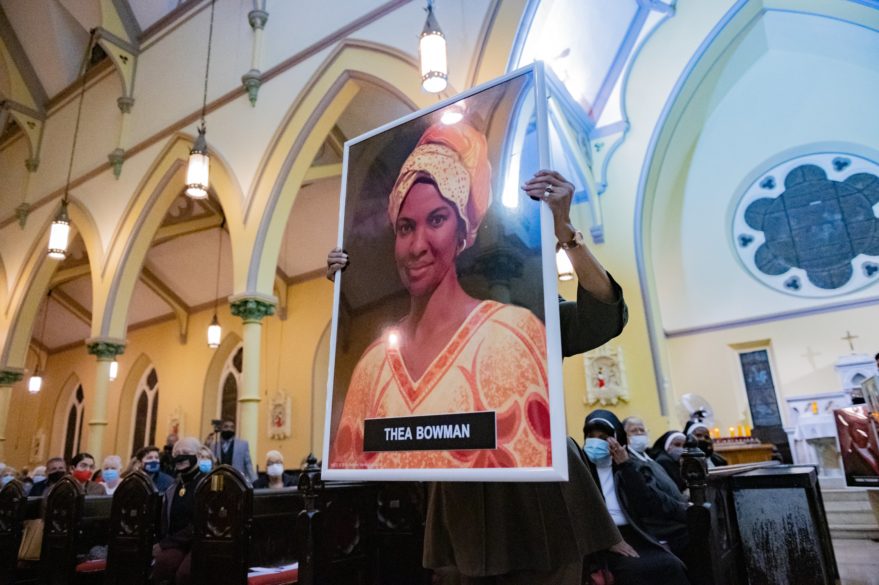
The title “Servant of God” is given by the church to a sainthood candidate when his or her cause is officially opened.
The first step in the process after that is the declaration of a person’s heroic virtues, after which the church bestows the title “Venerable.” The second step is beatification, after which he or she is called “Blessed.” The third step is canonization.
In general, for beatification one miracle needs to be accepted by the church as having occurred through the intercession of the prospective saint and a second such verified miracle is needed for canonization.
Following the procession, Auxiliary Bishop Bruce A. Lewandowski of Baltimore, the archdiocese’s urban vicar, celebrated a Mass for the feast of All Saints. Nearly 200 people were present.
The Mass was organized by a national campaign made up of members of three Baltimore parishes, St. Ann, St. Francis Xavier and St. Wenceslaus, as well as longtime members of St. Ann’s social justice committee.
The purpose was to create awareness and educate the American people about the stories of these six candidates for sainthood.
Members of the campaign are collecting signatures in a letter to Pope Francis asking him to expedite their canonization.
“While there are no U.S. African American saints, there are 11 white Americans who have been canonized,” the letter said. “We know there is a process, but it is not working for Black American Catholics and supporters. The process is reaping unfair, uneven results, especially when you realize that the six Black saints have been waiting 714 years totally if you add up the times since each died.”
Toussaint died 168 years ago, and a few of the others have been deceased for more than a century. Sister Bowman is the most contemporary, having died in 1990.
The letter asked the pope to canonize the six candidates “immediately.” “If not now, when?” it said. “If not you, who?”
Delores Moore, one of the leaders of the national campaign, a member of St. Ann’s social justice committee and a parishioner there, said the campaign started when parishioners serving the African American community realized only a few people knew about the lives of these African American holy men and women, who despite their struggles with systemic racism, remained loyal to God.
Father Donald Sterling, the first African American priest ordained in the Archdiocese of Baltimore and pastor of New All Saints in Liberty Heights, carried the portrait of Father Tolton, first African American diocesan priest in the United States.
“Besides being historical, it is humbling to think that in all these years I am the first African American priest in the Archdiocese of Baltimore,” Father Sterling said. “It is a humbling call on God’s part.”
Many present knew Sister Bowman, including Father Sterling and Therese Wilson Favors, a longtime Catholic educator and former director of the Baltimore archdiocesan Office of Black Catholic Ministries, who carried the portrait of her friend and co-worker.
Wilhelmena Braswell, a St. Ann parishioner, met Sister Bowman in the Basilica of the National Shrine of the Assumption of the Blessed Virgin Mary in downtown Baltimore and said “her presence would light up the room.”
Bishop Lewandowski said that in the church there are saints for every community and every person, but not in the case of the African American community.
He invited the congregation to share with everyone the stories of these future saints, to make sure their parishes display pictures of them and to ask for their intercession.
The bishop said it is important to have Masses to celebrate African American saints because the faithful identify with saints who “look like us, spoke our language, lived our experiences and can understand our struggles.”
Although the process of canonization can be long and tedious, Bishop Lewandowski encouraged the congregation by reminding them, “We don’t make saints; God does.”
(González de Doran writes for the Catholic Review, the news outlet of the Archdiocese of Baltimore.)
A time to pass it on: Diversity is a gift to the church
By Kathleen Merritt for The Catholic Miscellany
During November, Black Catholics across the country will tell stories, sing from our “Lead Me Guide Me” hymnals and praise God in thanksgiving. The many acts of significance our ancestors put forth in the name of Black spirituality and creating a place for Black Catholics in the church are a cause for joy and celebration.
Father Michael Okere, vicar for Black Catholics, said this month “calls us to rejoice for all the huddles our ancestors went through to sustain their faith in the Catholic Church. Also, it calls us to rejoice in hope as we practice our faith in deep spirituality, and to leave a strong Catholic faith legacy for the generations that will come after us.”
According to demographics found on the U.S. Conference of Catholic Bishops’ (USCCB) African American Demographics page, there are 3 million African American Catholics, 250 priests, 437 deacons, 75 in seminary formation for the priesthood, 400 religious sisters and 59 religious brothers.

The diocesan Office of Black Catholics frequently celebrates the history of our African American parishioners. They have persevered through the centuries, remaining true to the mission of evangelizing Black Catholics. It is the passing on of these stories to our youth, from generation to generation, that serve as one of our best resources. Families are the center of the church, and Black Catholic History Month celebrates our families in many ways.
There are no Black saints from the United States, which is why there is a strong movement for six African Americans on the road to sainthood today. Imagine the impact on youth that the sharing of the story of faith and perseverance of our first known African American priest, Venerable Father Augustus Tolton, can have.
If you’ve never heard a speech by Servant of God Sister Thea Bowman, please go to YouTube, search her name and listen. The talk she delivered to the USCCB in 1989 on Black spirituality was so powerful that all the bishops stood up, joined hands and engaged in singing and swaying to a Negro spiritual, with her leading the song. Sister Thea is among the African American candidates for sainthood.
Many in our diocese remember meeting Sister Thea when she visited and facilitated retreats on Black spirituality. The most enlightening thing about her visit to South Carolina is that there are some people alive today who, in future, may be able to say they spent time with a saint.
Among her many contributions to the evangelization of Black Catholics, Sister Thea was instrumental in the publication of the “Lead Me Guide Me” hymnal. It became a tool for outreach Catholic Churches in Black communities. Its second edition is now available and provides a wonderful enhancement to liturgies in all parishes, not just those that are historically African American. It is another resource that allows us and the church to embrace its diversity as a gift. In addition to Father Tolton and Sister Thea, there are four more African Americans on the path to sainthood.
Included are Henriette Delille and Mother Mary Lange, who started religious orders for women of color. DeLille founded Sisters of the Holy Family in 1836 and Lange co-founded the Oblates Sisters of Providence in 1829. The Oblates were the first religious community of women of African American descent.
Another on the road to sainthood is Pierre Toussaint. He arrived in the United States from Haiti and was one of New York’s most sought-after hairstylists. After he was given his freedom, he donated his accumulated wealth to help the poor in his community. Julia Greely, last of the six, also known as Denver’s “Angel of Charity,” provided assistance to countless families in poverty.
Black Catholic history was made again in 2020 when Archbishop Wilton D. Gregory became the first African American to be made cardinal. He was also the first Black president of the USCCB. Imagine if there had never been a Father Augustus Tolton to lead the way!
The Office of Ethnic Ministries published a book called My Little Black Catholic History Book, which focuses on African saints and popes, plus quizzes on Black Catholic history and an essay on Black Catholics in South Carolina. The book is free and can be downloaded from the office’s webpage.
(In addition to the book, visit charlestondiocese.org/ethnic-ministries for more Black Catholic History events and resources.)
Kathleen Merritt is the director of the diocesan Office of Ethnic Ministries. Email her at kmerritt@charlestondiocese.org.
Briefs
NATION
BALTIMORE (CNS) – The U.S. church today is called more than ever to carry out its centuries-long evangelizing mission at a time of spiritual awakening rising from “under the clouds of the pandemic” and the country’s uncertain future, the president of the U.S. Conference of Catholic Bishops told his fellow prelates. “People are starting to examine what they truly believe and what they value most deeply in their lives,” said Los Angeles Archbishop José H. Gomez, who spoke Nov. 16 during the opening public session of the USCCB’s Nov. 15-18 general assembly in Baltimore. The questions people have allow the church to continue its mission, even in an increasingly secularized society, the archbishop said. The challenge, he said, is “to understand how the church should carry out her mission.” Archbishop Gomez acknowledged that differences among members of the church exist because of the differing views people hold on how to move forward. Still, he said, “there are also many signs of hope” that present new opportunities to bring the Gospel to others. The archbishop turned to a 19th-century prelate to find inspiration for the path ahead. Archbishop John Ireland, who as a young priest served as a chaplain in the Union Army, was a “powerful advocate for African Americans and for the rights of immigrants,” he explained.
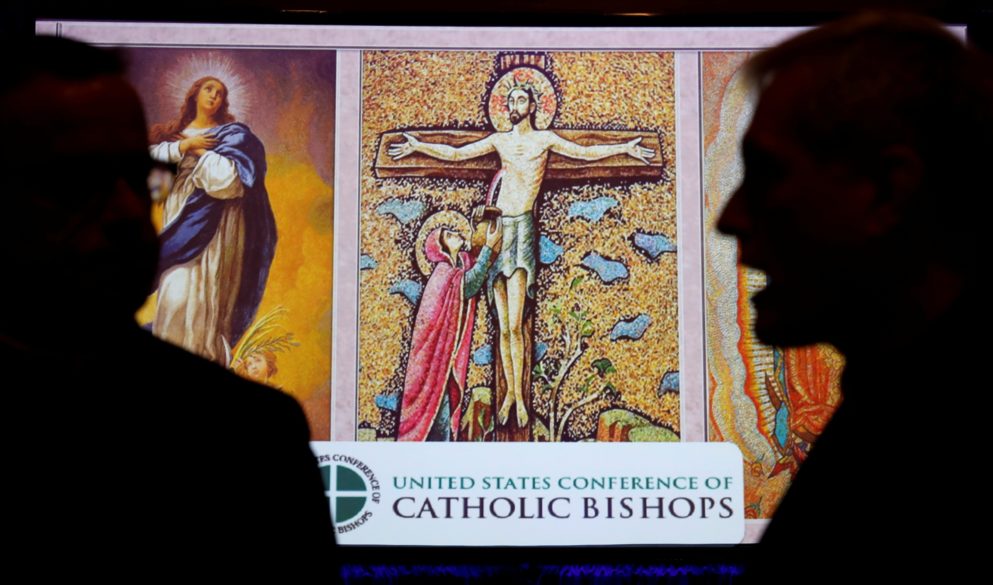
WASHINGTON (CNS) – A billboard will go up in New York’s Times Square during Christmas and New Year’s to promote and celebrate the evermore popular podcast “The Bible in a Year,” but more is in store for the program that topped the charts shortly after its debut in January. The creators of the daily podcast that leads listeners through the Bible’s narrative have announced several new initiatives designed to highlight the show’s success and attract even more listeners. An all-new Spanish-language version of the podcast – La Biblia en un año – with original commentary and a new, native-Spanish speaking host, will be launched Jan. 1. “The Bible in a Year Retreat” virtual event for listeners will take place Feb 18-20. It will have a limited capacity for participants but is “designed to help Catholics cultivate a lifelong relationship with the word of God – one that extends far beyond the podcast.” The planned billboard will be unveiled Dec. 19 in Times Square and will stay up through Jan. 9. “Through distraction and distress, our culture has lost a hopeful, historical biblical worldview – but by the grace of God this podcast has helped thousands rediscover it,” said Father Mike Schmitz, a priest of the Diocese of Duluth, Minnesota, and popular Catholic speaker and author, who hosts the podcast.
BANGOR, Maine (CNS) – “I hope he knows how awesome he is!” said a seventh grader at All Saints Catholic School when students sprang into action to honor Roy Ward of Bangor, a World War II veteran who celebrated his 102nd birthday on Veterans Day itself. All Saints students, who have a special appreciation for veterans, decided to create 102 birthday cards to celebrate Ward’s birthday and honor his service in the process. Ward served in the U.S. Navy in World War II as a machinist mate first class from 1941 to 1947, serving on three different vessels – USS Mizpah, USS Shenandoah and USS Yosemite. “It was too much of an opportunity for community service to pass up,” said Matthew Houghton, principal of All Saints in Bangor. “The cards are warm and creative and showcase the appreciation our students have for those who have fought for our freedom,” Houghton said.
VATICAN
VATICAN CITY (CNS) – Lasting peace in the world can be achieved only by responding to the needs of current and future generations, the Vatican said as it announced the theme Pope Francis chose for his 2022 World Peace Day message. “Education, work and dialogue between generations: tools for building lasting peace” will be the theme for the Jan. 1 commemoration and for the message Pope Francis will write for the occasion, said a Vatican communique published Nov. 13. The Vatican said education, work and dialogue are consistently evolving and that Pope Francis’ message will “propose an innovative reading that responds to the needs of current and future times.” The pope’s message, the communique said, will be an invitation “to read the signs of the times with the eyes of faith, so that the direction of this change awakens new and old questions with which it is right and necessary to be confronted.” Pope Francis will seek to answer questions about education and how it contributes to lasting peace, the Vatican said. He will also address how work can “respond more or less to the vital needs of human beings on justice and freedom.
VATICAN CITY (CNS) – Visiting Cyprus and Greece in early December, Pope Francis will have several meetings with the countries’ Orthodox leaders and with the migrants and refugees their nations host. While Catholics account for only a small percentage of the Christians in both countries, the pope will hold meetings in both Nicosia and Athens with priests, religious and seminarians and will celebrate public Masses in both cities. The Vatican Nov. 13 released the detailed schedule of the pope’s visit Dec. 2-4 to Cyprus and Dec. 4-6 to Greece, including a return visit to migrants and refugees on the island of Lesbos awaiting resettlement.
WORLD
HONG KONG (CNS) – A Chinese bishop who was allegedly kidnapped by authorities in late October has returned to his diocese, media reports say. Ucanews.com reported Bishop Peter Shao Zhumin of Wenzhou has resurfaced, with church officials and the faithful offering thanksgiving prayers for his return. It is still unknown when the 58-year-old bishop was released following his arrest Oct. 25. The authorities reportedly said the bishop was taken for “tourism.” Bishop Shao, ordained with a papal mandate as a coadjutor bishop in 2011, fell out of favor with the government as his appointment was not approved by the state-sanctioned Bishops’ Conference of the Catholic Church in China and the Chinese Catholic Patriotic Association. His refusal to join and collaborate with state-run bodies led to a series of arrests and detentions. Before this detention, he had been arrested six times, including for seven months in 2017. The whereabouts of Bishop Joseph Zhang Weizhu of Xinxiang remain unknown, ucanews.com reported. Bishop Zhang was arrested in May with 10 priests and an unspecified number of seminarians.
ASSISI, Italy (CNS) – With a mix of awe and excitement, pilgrims from many parts of Europe conquered the exhaustion of a long road trip and prepared to celebrate the World Day of the Poor with Pope Francis. Lukasz Baczkowski from Poland was a bit incredulous but proud that other members of his community supported by the Barka Foundation for Mutual Help elected him as one of their 10 representatives to the pope’s meeting with the poor in Assisi Nov. 12. They drove 24 hours in a Volkswagen bus to get to the hilltop town in central Italy. Baczkowski said St. Francis of Assisi is an “inspiration” for him. With his renunciation of his family’s wealth and his total devotion to serving God and God’s poor, the Assisi saint proved that “everyone can change. No one was a saint from the beginning,” Baczkowski told Catholic News Service Nov. 11 at a pilgrim hostel in Assisi. That is a message he clings to as he continues his journey of sobriety and of living in a community rather than on the streets. The faith aspect of the Barka community and of the pilgrimage is a key part of what Baczkowski sees as his redemption. “The most important thing is the soul of a man,” he said. Faith and a helping hand from other Catholics are what helped him move from sleeping on the street, drinking, stealing – and especially from having contemplated suicide, he said.
CIUDAD JUÁREZ, Mexico (CNS) – Thirteen-hundred miles from home, a group from the Diocese of Davenport, Iowa, on a border immersion trip encountered a young woman with two kids and a car with a flat tire in Ciudad Juárez. The group, which included five deacon candidates, their formation director, diocesan bishop and immersion experience leaders, stopped to change the tire. The unexpected encounter reinforced the purpose of the Iowans’ journey: to witness life on the border, to learn about the experience of migrants, and to better minister to migrants back home. “It is one thing to hear their stories, but it is quite another to see and be at one of the main crossing points from Mexico to the U.S.,” said Davenport Bishop Thomas R. Zinkula. “It is important to talk to and learn from people who are ministering to forcibly displaced persons at the border and to the migrants themselves,” he told The Catholic Messenger, newspaper of the Davenport Diocese. Their journey began Nov. 2 with a 20-hour drive in a van from Davenport to El Paso, Texas, where they took up residence at the Encuentro Project retreat house. The Encuentro Project provides a faith-based, multifaceted immersion program in the El Paso-Ciudad Juárez border region to give participants a deeper understanding of the complex migration reality and of the community. “Encuentro” is Spanish for “encounter.”
March for Life: Unborn must be part of current U.S. debate over inequality
By Kurt Jensen
WASHINGTON (CNS) – It’s a question Jeanne Mancini has already been asked so many times, she has an answer ready to go.
On Dec. 1, the Supreme Court hears oral arguments in Dobbs v. Jackson Women’s Health Organization, an appeal by Mississippi to remove a lower court’s injunction on its law banning most abortions after the 15th week of pregnancy.
Should the court rule in favor of the state law in a decision to be handed down next year, overturning Roe v. Wade and sending the abortion issue back to the states, will there still be a need for the annual rally and march in Washington?
Or will March for Life, a fixture since January 1974, instead become a decentralized arrangement of statewide marches?
“We will make an announcement if and when that happens,” Mancini, president of the March for Life Education and Defense Fund, told Catholic News Service.
State marches that began a few years ago, she said, were not planned in anticipation of any Supreme Court decision, but rather as a way “to strengthen the grassroots” and provide opportunities for activism for those who don’t make the long trip to Washington.
Carrie Severino, president of Judicial Crisis Network, identified the challenge should the court uphold the Mississippi law. “It really just puts the ball back in (the states’) court. There should be 50 Marches for Life,” she said during the Oct. 27 announcement of next year’s theme, “Equality Begins in the Womb.”
“We want to expand this rigorous debate about inequality” to the unborn, Mancini said at the Heritage Foundation, where the theme was announced.
Calling the theme a cry for “inherent human dignity because of who we are in our essence,” she added, “Injustice anywhere is a threat to injustice everywhere, including in the womb.”
Father Frank Pavone, national director of Priests for Life, said in a statement that “it reclaims a key word – equality – and reminds us that unless children in the womb enjoy it, the rest of us lose it as well.”
The March for Life is scheduled for Jan. 21. The event, which starts with a rally near the National Mall followed by a march to the Supreme Court, is always held on a date near the anniversary of the Supreme Court’s 1973 rulings, Roe v. Wade and Doe v. Bolton, companion rulings that legalized abortion nationwide.
“It’s going to be one of the most significant years for the march yet,” said Severino. “This court has an opportunity like none it has had before with the Dobbs case.”
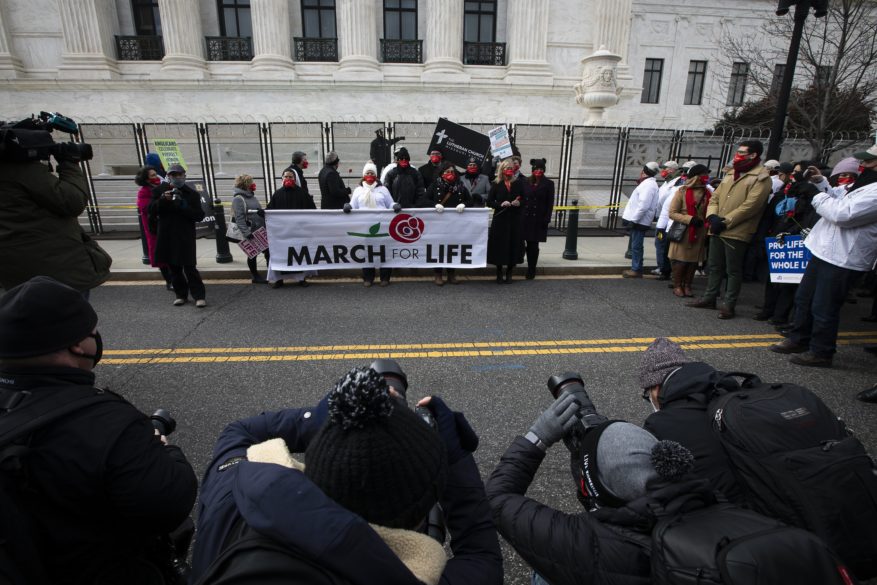
The Mississippi law was enacted in 2018, but it never took effect because a federal appellate court immediately blocked its enforcement. The state’s single abortion clinic is still performing them.
With Justice Amy Coney Barrett joining Justices Brett Kavanaugh and Neil Gorsuch, as well as Justices Samuel Alito and Clarence Thomas, Severino said, “we now have a majority of justices on the court who believe the Constitution must be interpreted according to its original understanding, and its original meaning.”
The turnout of more than 100,000 people for the 2020 March for Life is considered the all-time high for the event. Attendees packed the National Mall to hear President Donald Trump address the rally in person.
But in January of this year, the combination of the COVID-19 pandemic and heavy security following the Jan. 6 riot at the Capitol reduced the march to its smallest turnout – an invited core group of 80.
Instead of the usual march up Constitution Avenue, the group took a winding route through Washington streets to the Supreme Court and were joined midway by about 100 others.
“We never thought of not doing the march,” Mancini told CNS. But, she added, she didn’t think she could comment on whether any of the current plans represent “back to normal.”
Mancini, who has headed the march since 2012 when she took over from its founder, the late Nellie Gray, said: “I wouldn’t call any march I’ve been part of a predictable march. It’s always been a little bit unpredictable.”
The bus pilgrimages that traditionally bring thousands of marchers to the nation’s capital also are difficult to predict for 2022 until reservations are confirmed by organizers and bus companies.
At the University of Mary in Bismarck, North Dakota, Ed Konieczka, assistant director of university ministry, said their goal is to have 240 students, about 50 more than in 2020, head for Washington on five buses, with an event to be held in Bismarck coinciding with the national march.
John Pratt, director of youth ministry for the Diocese of Fort Wayne–South Bend, Indiana, told CNS that “if we are able to go, my sense would be that we would have about 80% of the participation as compared to recent years. In 2019 and 2020, we sent 10 busloads (just over 500 pilgrims) from our diocese.”
For 2022, he said, “350 to 400 (seven to eight busloads) is pretty realistic.”
Debate, vote on proposed eucharistic document will top U.S. bishops’ agenda
WASHINGTON (CNS) – When the U.S. bishops gather for their fall assembly in Baltimore Nov. 15-18, it will be the first in-person meeting of the full body of bishops since November 2019.
The COVID-19 pandemic forced the cancellation of the bishops’ June 2020 spring meeting, and their November 2020 fall assembly and June 2021 spring meeting were both held in a virtual format.
Topping the meeting’s agenda will be debate and votes on a proposed document on the Eucharist, “The Mystery of the Eucharist in the Life of the Church,” and on a eucharistic revival initiative.
During their spring meeting this past June, 75% of the U.S. bishops approved the drafting of a document, to all Catholic faithful, on eucharistic coherence.
Part of the impetus for the bishops’ work on this document and a eucharistic revival to increase Catholics’ understanding and awareness of the Eucharist was a Pew study in the fall of 2019 that showed just 30% of Catholics “have what we might call a proper understanding of Christ’s presence in the Eucharist.”
The eucharistic revival would launch on the feast of Corpus Christi in June 2022. The three-year effort will include events on the diocesan level such as eucharistic processions around the country along with adoration and prayer.
In 2023, the emphasis will be on parishes with resources available at the parish level to increase Catholics’ understanding of what the Eucharist really means. This would culminate in a National Eucharistic Congress in the summer of 2024.
The Baltimore assembly of the U.S. Conference of Catholic Bishops will begin with an address by Archbishop Christophe Pierre, papal nuncio to the United States.
The bishops also will hear from Archbishop José H. Gomez of Los Angeles, president of the USCCB.
The agenda also includes a report to the bishops from the National Advisory Council, a group created by the USCCB that is comprised of religious and laypeople primarily for consultation on action items and information reports presented to the bishops’ Administrative Committee.
Other action items on the agenda requiring debate and a vote will be an update of the “Socially Responsible Investment Guidelines”; a proposal to add St. Teresa of Kolkata to the “Proper Calendar for the Dioceses of the United States” as an optional memorial Sept. 5; a resolution on diocesan financial reporting; new English and Spanish versions of the Order of Christian Initiation of Adults; a translation of “Holy Communion and Worship of the Eucharistic Mystery Outside Mass”; “National Statutes for the Catechumenate” in English and Spanish; and the USCCB’s 2022 budget.
During the assembly, the bishops also will vote for a treasurer-elect for the USCCB, as well as chairmen-elect of five standing committees: Clergy, Consecrated Life and Vocations; Divine Worship; Domestic Justice and Human Development; Laity, Marriage, Family Life and Youth; and Migration.
The bishops elected will serve for one year as “elect” before beginning their three-year terms in their respective posts at the conclusion of the 2022 fall general assembly.
There also will be voting for board members for Catholic Relief Services, the U.S. bishops’ overseas relief and development agency, and the election of a new USCCB general secretary.
Also scheduled to take place will be a consultation of the bishops on the sainthood causes of Charlene Marie Richard and Auguste Robert “Nonco” Pelafigue.
Both have the title of “Servant of God” and were from the Diocese of Lafayette Louisiana, where Bishop J. Douglas Deshotel has officially opened their sainthood causes.
Charlene, a young Cajun girl who died of leukemia in 1959 at age 12, is regarded by many in south Louisiana and beyond as a saint, saying her intercession has resulted in miracles in their lives. She is known as “The little Cajun saint.”
Pelafigue was born in France and from the time he was almost 2 years old, he lived in Arnaudville, Louisiana. He died on the feast of the Sacred Heart of Jesus June 6, 1977. He is known for his decades of ministry in the League of Sacred Heart, Apostleship of Prayer – which is now called the Pope’s Worldwide Prayer Network.
The 2007 Vatican document “Sanctorum Mater” requires the diocesan bishop promoting a sainthood cause to consult with the body of bishops on the advisability of pursuing the cause.
Other items to be presented and discussed at the bishops’ assembly include:
– The 2021-2023 Synod of Bishops.
– The work of CRS, Catholic Charities USA and Catholic Legal Immigration Network Inc., or CLINIC.
– The 50th anniversary of the Catholic Campaign for Human Development, the U.S. bishops’ domestic anti-poverty program.
– The “Journeying Together” process of intercultural dialogue and encounter “focused on the church’s ministry with youth and young adults that fosters understanding and trust within and across cultural families toward a more welcoming and just community of faith.”
– The application and implementation of the “ Pastoral Framework for Marriage and Family Life Ministry in the United States: Called to the Joy of Love.” At their June assembly, the U.S. bishops approved a draft document that provides a pastoral framework meant to strengthen marriage and family ministry in parishes and dioceses.
– The “Walking with Moms in Need” initiative of the USCCB Committee on Pro-Life Activities that asks every diocese and parish to help mothers experiencing a difficult pregnancy find services and resources or provide these when they see gaps in such services.
Public sessions of general assembly discussions and votes will be livestreamed at www.usccb.org/meetings.
Nación y Mundo en Fotos
